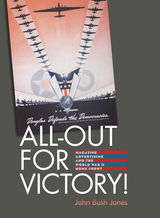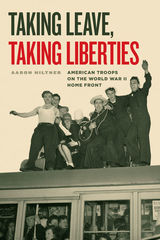2 books about World War II Home Front

All-Out for Victory!
Magazine Advertising and the World War II Home Front
John Bush Jones
Brandeis University Press, 2009
Following the attack on Pearl Harbor and the entry of the United States into World War II, many commercial advertisers and their Madison Avenue ad agencies instantly switched from selling products and services to selling the home front on ways to support the war. Ads by major manufacturers showcased how their factories had turned to war production, demonstrating their participation in the war and helping people understand, for instance, that they couldn’t buy a new washing machine because the company was making munitions. Other ads helped civilians cope with wartime rationing and shortages by offering advice on how to make leftovers tasty, make shoes last, and keep a car in good working order. Ads also encouraged Victory Gardens, scrap collecting, giving blood, and (most important) buying War Bonds. In this book, Jones examines hundreds of ads from ten large-circulation news and general-interest magazines of the period. He discusses motivational war ads, ads about industrial and agricultural support of the war, ads directed at uplifting the morale of civilians and GIs, and ads promoting home front efficiency, conservation, and volunteerism. Jones also includes ads praising women in war work and the armed forces and ads aimed at recruiting more women. Taken together, war ads in national magazines did their part to create the most efficient home front possible in order to support the war effort.
[more]

Taking Leave, Taking Liberties
American Troops on the World War II Home Front
Aaron Hiltner
University of Chicago Press, 2020
American soldiers overseas during World War II were famously said to be “overpaid, oversexed, and over here.” But the assaults, rapes, and other brutal acts didn’t only happen elsewhere, far away from a home front depicted as safe and unscathed by the “good war.” To the contrary, millions of American and Allied troops regularly poured into ports like New York and Los Angeles while on leave. Euphemistically called “friendly invasions,” these crowds of men then forced civilians to contend with the same kinds of crime and sexual assault unfolding in places like Britain, France, and Australia.
With unsettling clarity, Aaron Hiltner reveals what American troops really did on the home front. While GIs are imagined to have spent much of the war in Europe or the Pacific, before the run-up to D-Day in the spring of 1944 as many as 75% of soldiers were stationed in US port cities, including more than three million who moved through New York City. In these cities, largely uncontrolled soldiers sought and found alcohol and sex, and the civilians living there—women in particular—were not safe from the violence fomented by these de facto occupying armies. Troops brought their pocketbooks and demand for “dangerous fun” to both red-light districts and city centers, creating a new geography of vice that challenged local police, politicians, and civilians. Military authorities, focused above all else on the war effort, invoked written and unwritten legal codes to grant troops near immunity to civil policing and prosecution.
The dangerous reality of life on the home front was well known at the time—even if it has subsequently been buried beneath nostalgia for the “greatest generation.” Drawing on previously unseen military archival records, Hiltner recovers a mostly forgotten chapter of World War II history, demonstrating that the war’s ill effects were felt all over—including by those supposedly safe back home.
With unsettling clarity, Aaron Hiltner reveals what American troops really did on the home front. While GIs are imagined to have spent much of the war in Europe or the Pacific, before the run-up to D-Day in the spring of 1944 as many as 75% of soldiers were stationed in US port cities, including more than three million who moved through New York City. In these cities, largely uncontrolled soldiers sought and found alcohol and sex, and the civilians living there—women in particular—were not safe from the violence fomented by these de facto occupying armies. Troops brought their pocketbooks and demand for “dangerous fun” to both red-light districts and city centers, creating a new geography of vice that challenged local police, politicians, and civilians. Military authorities, focused above all else on the war effort, invoked written and unwritten legal codes to grant troops near immunity to civil policing and prosecution.
The dangerous reality of life on the home front was well known at the time—even if it has subsequently been buried beneath nostalgia for the “greatest generation.” Drawing on previously unseen military archival records, Hiltner recovers a mostly forgotten chapter of World War II history, demonstrating that the war’s ill effects were felt all over—including by those supposedly safe back home.
[more]
READERS
Browse our collection.
PUBLISHERS
See BiblioVault's publisher services.
STUDENT SERVICES
Files for college accessibility offices.
UChicago Accessibility Resources
home | accessibility | search | about | contact us
BiblioVault ® 2001 - 2024
The University of Chicago Press









